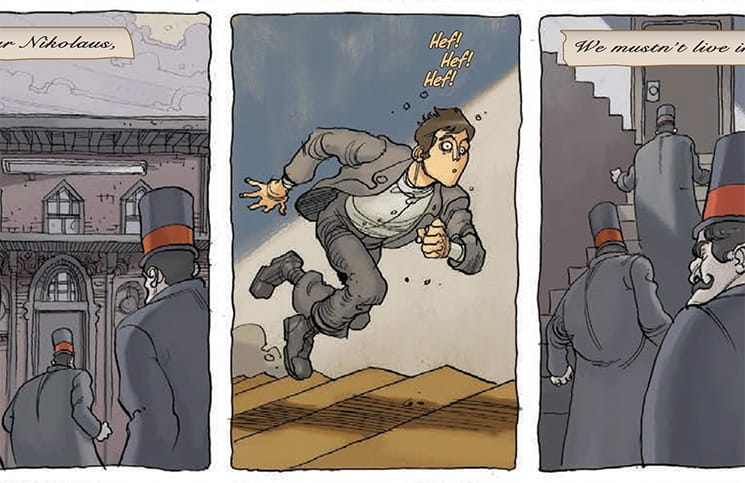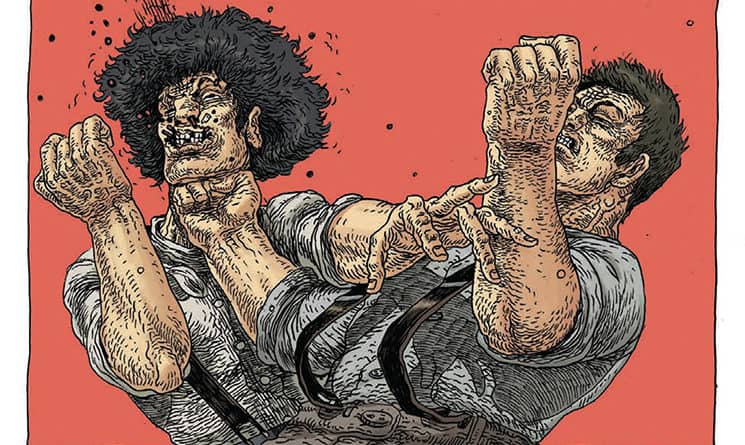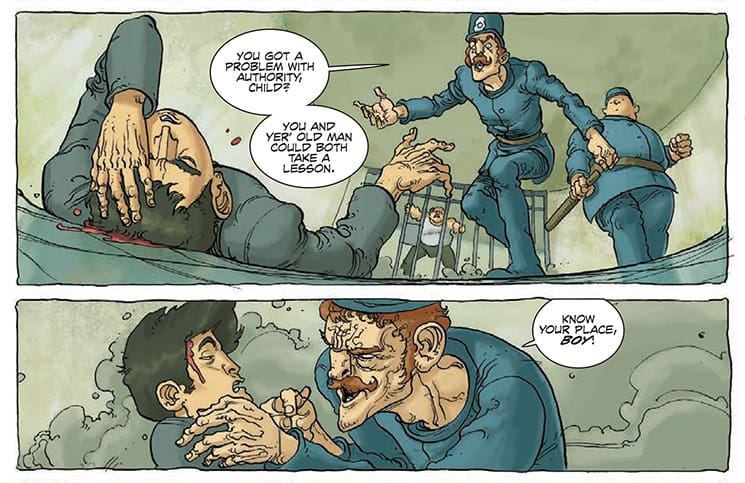Cory Levine spent eight years living in New York City and working as an editor for Marvel Comics. Six of those years were pretty good, he says; two were kind of lousy. When he started writing “Bowery Boys,” his first graphic novel about life in mid-19th century Manhattan, in 2011, all those “years of frustration and anxiety about urbanity” found an outlet.
“You can’t live in New York without developing a relationship with it, for better or for worse,” he says.
Levine left New York for Epping two years ago, and now, after four years of work, he’s celebrating another milestone — publisher Dark Horse Comics is set to release “Bowery Boys: Our Fathers” in comic shops on Aug. 5 and in bookstores on Aug. 18. Levine will be signing copies of the book at Stairway to Heaven Comics in Exeter on Wednesday, Aug. 5.
“Bowery Boys” is, in Levine’s words, “’Stand By Me’ meets ‘Gangs of New York.’” A collaboration with artists Ian Bertram and Brent McKee, the book follows Niko McGovern, whose union boss father is framed for murder. Niko enlists the aid of a ragtag group of friends — street kids Paully and Mary Ann, and Isaac, a member of the neighborhood’s Jewish gang — to clear his father’s name and strike back against Roderick Pastor, the millionaire who orchestrated the frame-up.
Levine grew in Worcester, Mass. and later went to the University of New Hampshire, where he graduated in 2005. He moved to New York City soon after and started his career. First an editorial assistant and, later, a special projects editor at Marvel Comics, Levine worked on getting hundreds of books published.
All those books that went across his desk inspired him to start writing his own comics. “I saw a lot of unimpressive work coming across my desk … and I believed I could create something worth putting out in the world,” he says.
Levine met up with artist Ian Bertram, and the two started work on “Bowery Boys” in 2011. “I wanted to create something specific to his strengths, and writing about New York was the landing point for us,” Levine says.
“Bowery Boys” captures both sides of the city. Bertram’s art draws inspiration from artists like Richard Corben and French comics creator Jean Giraud (otherwise known as Moebius) — it’s stylishly grimy, extremely detailed, and unsparing when it comes to capturing the brutal realities of life in the city’s slums and working-class neighborhoods. But there’s hope, too. Though the cast is full of scoundrels, villains, and psychopaths, Niko, Paully, Isaac, and others stay true to themselves, despite terrible costs.
According to Levine, the antebellum era of New York City is untapped territory for comics. He did extensive research to help capture period details, using sources like Jacob Riis’ groundbreaking 1890 book of photojournalism, “How the Other Half Lives,” to ground “Bowery Boys” in reality. Most of the characters and plot points spun out of that research, he says.
“It was a matter of … finding things that inspired me and then putting them together, like a puzzle,” he says.
Because a union strike drives the book’s plot, there’s plenty of talk about labor, capitalism, and workers standing up against the rich — language that’s taken over the political conversations of the last four years.
“I kind of stumbled into a thematic goldmine,” Levine says. “There are so many issues that are reflected in the socio-political struggle of the day, so hopefully it will strike a chord” with readers.

When Levine and Bertram began work on the book, they hoped it would quickly be picked up by a major publisher. It was a tough sell, though. The unique setting and genre — historical fiction mixed with a gritty crime story — meant publishers weren’t sure how to market the book. And so Levine and Bertram took the comic to the Web, where they published it a page at a time.
“It was written and designed to be published as a book … but that was the outlet available to us,” Levine says.
It eventually paid off — publishing “Bowery Boys” as a Web comic built up a fan base and attracted the attention of Dark Horse Comics, one of the top independent comic publishers. The path to publication was “long and winding,” Levine says. He and his wife moved to New Hampshire two years ago and, along the way, he’s done freelance work and other projects, all with an eye toward funding the development of “Bowery Boys.”
The project picked up another artist, too — penciler Brent McKee took over artistic duties when Bertram left near the end of the book. Levine says working with both artists has been a great collaboration.
“You have to have a really strong working relationship and trust each other implicitly,” Levine says.
Now that “Bowery Boys” is out, Levine is working on other projects. He has a story coming out in the second volume of “Colonial Comics,” an anthology series of Colonial-era fiction, slated for publication in 2016. He’s open to working
across multiple genres and mediums, though.
“I’m still fairly new to the writing game, and I’m fortunate to have a debut work coming out from a notable publisher,” he says. “I’m not ready to declare myself as a specific genre writer, or a writer in a specific medium.”
Cory Levine will sign copies of “Bowery Boys: Our Fathers” on Wednesday, Aug. 5, 5:30-8 p.m. at Stairway to Heaven Comics, 121 Water St., Exeter. Call 603-580-4682. “Bowery Boys” is available online at boweryboyscomic.com.


